Related Research Articles
Electronic music is music that employs electronic musical instruments, digital instruments, or circuitry-based music technology in its creation. It includes both music made using electronic and electromechanical means. Pure electronic instruments depended entirely on circuitry-based sound generation, for instance using devices such as an electronic oscillator, theremin, or synthesizer. Electromechanical instruments can have mechanical parts such as strings, hammers, and electric elements including magnetic pickups, power amplifiers and loudspeakers. Such electromechanical devices include the telharmonium, Hammond organ, electric piano and the electric guitar.

An electronic musical instrument or electrophone is a musical instrument that produces sound using electronic circuitry. Such an instrument sounds by outputting an electrical, electronic or digital audio signal that ultimately is plugged into a power amplifier which drives a loudspeaker, creating the sound heard by the performer and listener.

Digital music technology encompasses digital instruments, computers, electronic effects units, software, or digital audio equipment by a performer, composer, sound engineer, DJ, or record producer to produce, perform or record music. The term refers to electronic devices, instruments, computer hardware, and software used in performance, playback, recording, composition, mixing, analysis, and editing of music.
In music, a loop is a repeating section of sound material. Short sections can be repeated to create ostinato patterns. Longer sections can also be repeated: for example, a player might loop what they play on an entire verse of a song in order to then play along with it, accompanying themselves.

In music, tape loops are loops of magnetic tape used to create repetitive, rhythmic musical patterns or dense layers of sound when played on a tape recorder. Originating in the 1940s with the work of Pierre Schaeffer, they were used among contemporary composers of 1950s and 1960s, such as Éliane Radigue, Steve Reich, Terry Riley, and Karlheinz Stockhausen, who used them to create phase patterns, rhythms, textures, and timbres. Popular music authors of 1960s and 1970s, particularly in psychedelic, progressive and ambient genres, used tape loops to accompany their music with innovative sound effects. In the 1980s, analog audio and tape loops with it gave way to digital audio and application of computers to generate and process sound.
Electroacoustic music is a genre of Western art music in which composers use technology to manipulate the timbres of acoustic sounds, sometimes by using audio signal processing, such as reverb or harmonizing, on acoustical instruments. It originated around the middle of the 20th century, following the incorporation of electric sound production into compositional practice. The initial developments in electroacoustic music composition to fixed media during the 20th century are associated with the activities of the Groupe de recherches musicales at the ORTF in Paris, the home of musique concrète, the Studio for Electronic Music in Cologne, where the focus was on the composition of elektronische Musik, and the Columbia-Princeton Electronic Music Center in New York City, where tape music, electronic music, and computer music were all explored. Practical electronic music instruments began to appear in the early 1900s.
The Computer Music Center (CMC) at Columbia University is the oldest center for electronic and computer music research in the United States. It was founded in the 1950s as the Columbia-Princeton Electronic Music Center.
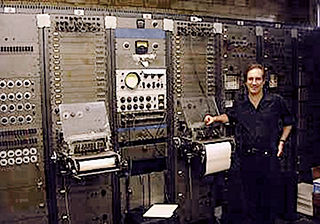
The RCA Mark II Sound Synthesizer was the first programmable electronic synthesizer and the flagship piece of equipment at the Columbia-Princeton Electronic Music Center. Designed by Herbert Belar and Harry Olson at RCA, it was installed at Columbia University in 1957. Consisting of a room-sized array of interconnected sound synthesis components, much of the design of the machine was contributed by Vladimir Ussachevsky and Peter Mauzey. The Mark II gave the user more flexibility and had twice the number of tone oscillators as its predecessor, the Mark I. The synthesizer was funded by a large grant from the Rockefeller Foundation.
Otto Clarence Luening was a German-American composer and conductor, and an early pioneer of tape music and electronic music.
Paul Henry Beaver Jr. was an American musician who was a pioneer in popular electronic music, using the Moog synthesizer. From 1967, Beaver collaborated with Bernie Krause as the recording duo Beaver & Krause.

The Moog synthesizer is a modular synthesizer developed by the American engineer Robert Moog. Moog debuted it in 1964, and Moog's company R. A. Moog Co. produced numerous models from 1965 to 1981, and again from 2014. It was the first commercial synthesizer, and is credited with creating the analog synthesizer as it is known today.
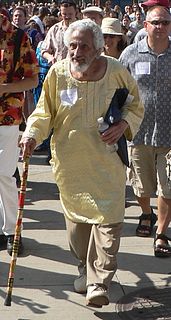
Halim Abdul Messieh El-Dabh was an Egyptian composer, musician, ethnomusicologist, and educator, who had a career spanning six decades. He is particularly known as an early pioneer of electronic music. In 1944 he composed one of the earliest known works of tape music, or musique concrète. From the late 1950s to early 1960s he produced influential work at the Columbia-Princeton Electronic Music Center.
Vladimir Alexeevich Ussachevsky was a composer, particularly known for his work in electronic music.
Alice Shields is an American classical composer. She is a respected electronic composer particularly known for her cross-cultural work in opera.
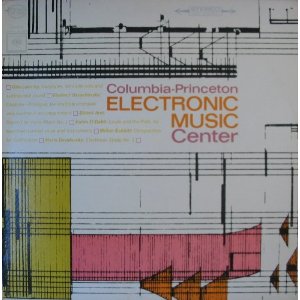
Columbia-Princeton Electronic Music Center was an album of electronic music released in 1964. It was the recording of a concert performed at the McMillin Theater at Columbia University on May 9 and 10, 1961. The stereo version was MS 6566 and the monophonic version was ML 5966. There was a sequel released in 1998 on the New World label titled Columbia-Princeton Electronic Music Center 1961–1973. Bülent Arel is the only artist who appears on both albums.

A synthesizer is an electronic musical instrument that generates audio signals. Synthesizers typically create sounds by generating waveforms, through methods including subtractive synthesis, additive synthesis and frequency modulation synthesis. These sounds may be altered by components such as filters, which cut or boost frequencies; envelopes, which control articulation, or how notes begin and end; and low-frequency oscillators, which modulate parameters such as pitch, volume, or filter characteristics affecting timbre. Synthesizers are typically played with keyboards or controlled by sequencers, software or other instruments, and may be synchronized to other equipment via MIDI.
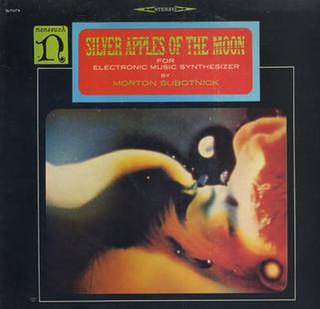
Silver Apples of the Moon is the debut album by American composer and musician Morton Subotnick, released by Nonesuch Records in July 1967. It contains the titular composition which is divided into two parts. A showcase for the Buchla 100 synthesizer, an early analogue synthesizer that the composer helped develop, it was the first piece of electronic music commissioned by a record company.
In sound and music, an envelope describes how a sound changes over time. It may relate to elements such as amplitude (volume), frequencies or pitch. For example, a piano key, when struck and held, creates a near-immediate initial sound which gradually decreases in volume to zero.
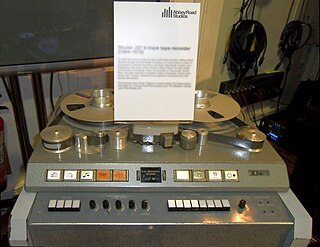
In music production, the recording studio is often treated as a musical instrument when it plays a significant role in the composition of music. Sometimes called "playing the studio", the approach is typically embodied by artists or producers who favor the creative use of studio technology in record production, as opposed to simply documenting live performances in studio. Techniques include the incorporation of non-musical sounds, overdubbing, tape edits, sound synthesis, audio signal processing, and combining segmented performances (takes) into a unified whole.
Michiko FrancoiseToyama Muto was a Japanese American composer. She was one of the first women invited to study at the Columbia–Princeton Electronic Music Center.
References
- ↑ "Astronauta Pinguim: Interview with Peter Mauzey". Astronauta Pinguim. 2014-05-10.
- ↑ Schwartz, Elliott. Contemporary Composers on Contemporary Music. New York, Holt, Rinehart and Winston [1967] OCLC 422238 p.258
- ↑ Hartsock, Ralph, and Carl Rahkonen. Vladimir Ussachevsky: A Bio-Bibliography. Westport, Conn. [u.a.]: Greenwood Press, 2000. ISBN 978-0-313-29852-3 p.8,9
- ↑ Lysloff, Rene T. A. Music and Technoculture. Music/culture. Middletown, Conn: Wesleyan Univ. Press, 2003. ISBN 978-0-8195-6514-3
- 1 2 Holmes, Thom. Electronic and Experimental Music: Technology, Music, and Culture. New York: Routledge, 2008. ISBN 978-0-415-95781-6 p.209